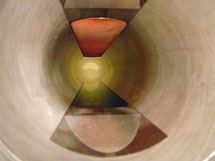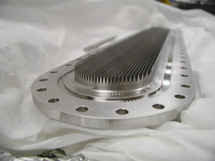
Handy Links
SLAC News Center
SLAC Today
- Subscribe
- Archives: Feb 2006-May 20, 2011
- Archives: May 23, 2011 and later
- Submit Feedback or Story Ideas
- About SLAC Today
SLAC News
Lab News
- Interactions
- Lightsources.org
- ILC NewsLine
- Int'l Science Grid This Week
- Fermilab Today
- Berkeley Lab News
- @brookhaven TODAY
- DOE Pulse
- CERN Courier
- DESY inForm
- US / LHC
SLAC Links
- Emergency
- Safety
- Policy Repository
- Site Entry Form

- Site Maps
- M & O Review
- Computing Status & Calendar
- SLAC Colloquium
- SLACspeak
- SLACspace
- SLAC Logo
- Café Menu
- Flea Market
- Web E-mail
- Marguerite Shuttle
- Discount Commuter Passes
-
Award Reporting Form
- SPIRES
- SciDoc
- Activity Groups
- Library
Stanford
Around the Bay
Groovy Beam Pipe Update
Something unwanted lurks within accelerator beam pipes around the world: stray electrons. This haze of electrons interacts with positron and proton beams, often causing distortion. Previous tests showed that an insert designed by SLAC researchers works well to capture stray electrons in an environment with no magnetic field. Now, recent tests carried out at the Japanese accelerator facility KEK confirm that a new insert can reduce this electron cloud effect in a magnetic field.
The tests show that triangular grooves on the beam pipe's interior surface trap stray electrons spiraling through the magnetic field, reducing the number of electrons in the cloud by up to a factor of 10. (Read more about the design in "Don't Rain on My Parade.") The results indicate a significant overall decrease in the number of electrons in the KEK beam pipe. Better yet, the number of electrons detected continued to decrease over the duration of each test, suggesting that the electron cloud will continue to shrink over even longer periods of time.
"The tests went great," said SLAC researcher Mauro Pivi, who designed the new beam pipe with SLAC colleagues Lanfa Wang and Tor Raubenheimer, working with KEK physicists Yusuke Suetsugu and Hitoshi Fukuma. "This is a very good start, and we look forward to even better results as we optimize the design."
As Pivi notes, this is just the beginning of testing. Later this year, slightly modified versions of the grooved beam pipe—this time with smaller grooves and an enhanced coating of titanium nitride to reduce the number of electrons produced—will be sent to KEK, the European accelerator laboratory CERN and the Cornell Electron Storage Ring Test Accelerator to be tested in different magnetic environments.
—Kelen Tuttle
SLAC Today, January 27, 2009

